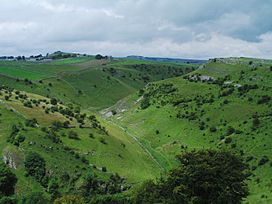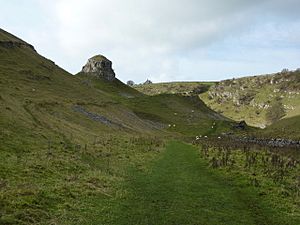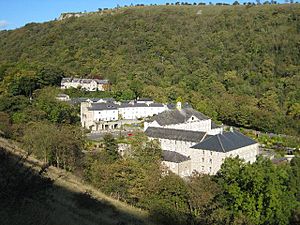Cressbrook Dale facts for kids
Quick facts for kids Cressbrook Dale |
|
|---|---|
| Ravensdale | |

Cressbrook Dale Nature Reserve
|
|
| Length | 2.5 miles (4 km) North-South |
| Width | 450 metres (1,476 ft) |
| Depth | 100 metres (328 ft) |
| Geography | |
| Location | Derbyshire, England |
| Rivers | winterbourne stream |
Cressbrook Dale (also known as Ravensdale) is a cool valley in the Peak District of England. It's near Bakewell, in Derbyshire. This valley is a dry gorge made of Carboniferous Limestone, which is a type of rock. It's carved into a flat area of farmland. The village of Cressbrook is at the bottom of the valley. Even though it's dry in summer, a special stream called a winterbourne flows here in winter. This stream eventually joins the River Wye.
Contents
What is Cressbrook Dale?
Cressbrook Dale is a special place for nature. It's part of the Derbyshire Dales National Nature Reserve. This reserve is managed by Natural England. It includes five different valleys in the White Peak area. These are Lathkill Dale, Cressbrook Dale, Hay Dale, Long Dale, and Monk’s Dale.
Plants and Trees
In the reserve, you can find different kinds of trees. These include ash and wych elm. There are also many shrubs like dog’s mercury and hazel. You might spot pretty wildflowers too. Some examples are lily-of-the-valley and ramsons.
The grasslands here have interesting plants. You can see meadow oat and carnation sedge. There are also patches of a rare plant called bird’s-foot sedge.
A Site of Special Scientific Interest
Cressbrook Dale is also a Site of Special Scientific Interest (SSSI). This means it's very important for its natural features. It's especially known for the unique lichens that grow on its limestone rocks.
How Was Cressbrook Dale Formed?
The rocks in Cressbrook Dale tell an amazing story. They are important for understanding geology. The layers of limestone were formed a very long time ago. This was about 330 million years ago, during the Carboniferous period. At that time, this area was a warm, shallow sea.
Fossils and Volcanoes
These ancient limestones contain important fossils. They show us what life was like back then. You can also see layers of volcanic rock. This tells us that volcanoes were once active in Derbyshire.
Peter's Stone
One famous rock formation is Peter's Stone. It's a large limestone hill at the north end of the valley. It got its name because it looks a bit like the dome of St. Peter's Basilica in Rome. Long ago, this spot was called Gibbet Rock. It was where the last gallows in the county stood.
Ravencliffe Cave
High up on the cliff above Ravensdale Cottages is Ravencliffe Cave. It's about 8 meters deep. In the early 1900s, people found many old items inside the cave. These included tools from the Stone Age and objects from the Bronze Age and Roman times. They found things like polished stone axes, arrowheads, pottery, beads, and bronze brooches. Human and animal bones were also discovered there.
Rock Climbing
The cliffs in Cressbrook Dale are popular for rock climbing. Ravensdale Cliff has many climbing routes. They can be up to 46 meters long. The cliffs at Water-cum-Jolly, at the bottom of Cressbrook Dale, are also great for climbers. They have over 400 different routes!
What About Industry in the Valley?
Cressbrook Dale also has a history of industry.
Lead Mining
There was a large lead mining area at Tansley Dale. This is now a protected historical site. You can still see old stone walls and earthworks from the mining days. In the middle of the valley are Ravensdale Cottages. Locals call them 'The Wick'. These two rows of cottages were built in 1823 for lead miners. They are now protected as Grade II listed buildings.
Cressbrook Mill
At the very bottom of the valley, near the River Wye, stands Cressbrook Mill. This large cotton mill was built in 1814–15. It replaced an older mill from 1779 that had burned down. The clock and the fancy top part of the mill were added in 1837. This was to celebrate Queen Victoria becoming queen. The mill stopped working in 1965. It is now a Grade II* listed building, which means it's very important historically.
How to Visit Cressbrook Dale
It's easy to explore Cressbrook Dale. There's a simple footpath that runs along the valley floor. The Monsal Trail is a path for walkers and cyclists. It runs along the Wye valley at the south end of Cressbrook Dale. You can get into the valley from both ends. There are also two footpaths from Litton village that lead into the west side of the valley. You can find some parking along the road in Upperdale, near the south end of the dale.



